Related Research Articles

The Austronesian languages are a language family widely spoken throughout Maritime Southeast Asia, parts of Mainland Southeast Asia, Madagascar, the islands of the Pacific Ocean and Taiwan. They are spoken by about 328 million people. This makes it the fifth-largest language family by number of speakers. Major Austronesian languages include Malay, Javanese, Sundanese, Tagalog, Malagasy and Cebuano. According to some estimates, the family contains 1,257 languages, which is the second most of any language family.
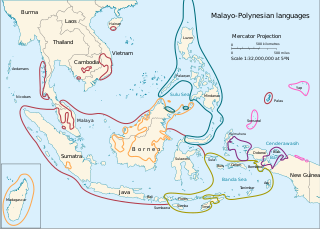
The Malayo-Polynesian languages are a subgroup of the Austronesian languages, with approximately 385.5 million speakers. The Malayo-Polynesian languages are spoken by the Austronesian peoples outside of Taiwan, in the island nations of Southeast Asia and the Pacific Ocean, with a smaller number in continental Asia in the areas near the Malay Peninsula, with Cambodia, Vietnam and the Chinese island Hainan as the northwest geographic outlier. Malagasy, spoken on the island of Madagascar off the eastern coast of Africa in the Indian Ocean, is the furthest western outlier.
The Western Malayo-Polynesian (WMP) languages, also known as the Hesperonesian languages, are a paraphyletic grouping of Austronesian languages that includes those Malayo-Polynesian languages that do not belong to the Central–Eastern Malayo-Polynesian (CEMP) branch. This includes all Austronesian languages spoken in Madagascar, Mainland Southeast Asia, the Philippines, Indonesia, also Bali, Lombok, and the western half of Sumbawa, Palau and the Mariana Islands.

The Philippine languages or Philippinic are a proposed group by R. David Paul Zorc (1986) and Robert Blust that include all the languages of the Philippines and northern Sulawesi, Indonesia—except Sama–Bajaw and the Molbog language (disputed)—and form a subfamily of Austronesian languages. Although the Philippines is near the center of Austronesian expansion from Taiwan, there is relatively little linguistic diversity among the approximately 150 Philippine languages, suggesting that earlier diversity has been erased by the spread of the ancestor of the modern Philippine languages.
Kanakanavu is a Southern Tsouic language spoken by the Kanakanavu people, an indigenous people of Taiwan. It is a Formosan language of the Austronesian family.

The Malayic languages are a branch of the Malayo-Polynesian subgroup of the Austronesian language family. The two most prominent members of this branch are Indonesian and Malay. Indonesian is the official language of Indonesia and has evolved as a standardized form of Malay with distinct influences from local languages and historical factors. Malay, in its various forms, is recognized as a national language in Brunei, Malaysia, and Singapore. The Malayic branch also includes local languages spoken by ethnic Malays, further several languages spoken by various other ethnic groups of Sumatra, Indonesia and Borneo even as far as Urak Lawoi in the southwestern coast of Thailand.
Proto-Oceanic is a proto-language that historical linguists since Otto Dempwolff have reconstructed as the hypothetical common ancestor of the Oceanic subgroup of the Austronesian language family. Proto-Oceanic is a descendant of the Proto-Austronesian language (PAN), the common ancestor of the Austronesian languages.
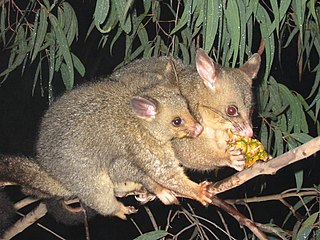
The Phalangeridae are a family of mostly nocturnal marsupials native to Australia, New Guinea, and Eastern Indonesia, including the cuscuses, brushtail possums, and their close relatives. Considered a type of possum, most species are arboreal, and they inhabit a wide range of forest habitats from alpine woodland to eucalypt forest and tropical jungle. Many species have been introduced to various non-native habitats by humans for thousands of years.
Proto-Austronesian is a proto-language. It is the reconstructed ancestor of the Austronesian languages, one of the world's major language families. Proto-Austronesian is assumed to have begun to diversify c. 4000 BCE – c. 3500 BCE in Taiwan.

Robert A. Blust was an American linguist who worked in several areas, including historical linguistics, lexicography and ethnology. He was Professor of Linguistics at the University of Hawaiʻi at Mānoa. Blust specialized in the Austronesian languages and made major contributions to the field of Austronesian linguistics.
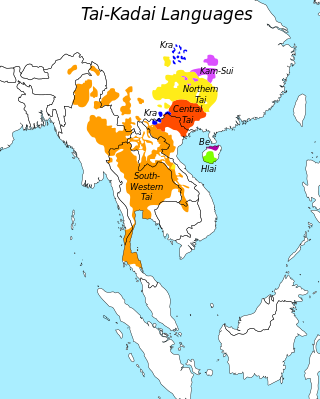
The Austro-Tai languages, sometimes also Austro-Thai languages, are a proposed language family that comprises the Austronesian languages and Kra–Dai languages.
The Greater North Borneo languages are a proposed subgroup of the Austronesian language family. The subgroup historically covers languages that are spoken throughout much of Borneo and Sumatra, as well as parts of Java, and Mainland Southeast Asia. The Greater North Borneo hypothesis was first proposed by Robert Blust (2010) and further elaborated by Alexander Smith. The evidence presented for this proposal are solely lexical. Despite its name, this branch has been now widespread within the Maritime Southeast Asia region.
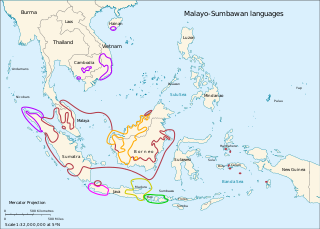
The Malayo-Sumbawan languages are a proposed subgroup of the Austronesian languages that unites the Malayic and Chamic languages with the languages of Java and the western Lesser Sunda Islands, except for Javanese. If valid, it would be the largest demonstrated family of Malayo-Polynesian outside Oceanic. The Malayo-Sumbawan subgroup is however not universally accepted, and is rejected e.g. by Blust (2010) and Smith (2017), who supported the Greater North Borneo and Western Indonesian hypotheses. In a 2019 paper published in Oceanic Linguistics, Adelaar accepted both of these groupings, in addition to Smith's (2018) redefinition of Barito languages as forming a linkage.
The Sabahan languages are a group of Austronesian languages mostly concentrated in the Malaysian state of Sabah, but also extended into neighbouring Sarawak of Malaysia, North Kalimantan of Indonesia, and the sovereign state of Brunei.
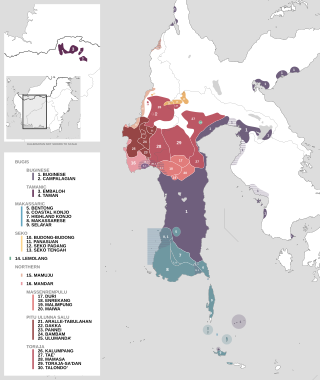
The South Sulawesi languages are a subgroup of the Austronesian language family. They are primarily spoken in the Indonesian provinces of South Sulawesi and West Sulawesi, with a small outlying pocket in West Kalimantan (Tamanic).
Isidore Dyen was an American linguist, Professor Emeritus of Malayo-Polynesian and Comparative Linguistics at Yale University. He was one of the foremost scholars in the field of Austronesian linguistics, publishing extensively on the reconstruction of Proto-Austronesian phonology and on subgrouping within the language family, the latter principally by means of lexicostatistics.
The Greater Central Philippine languages are a proposed subgroup of the Austronesian language family, defined by the change of Proto-Malayo-Polynesian *R to *g. They are spoken in the central and southern parts of the Philippines and in northern Sulawesi, Indonesia. This subgroup was first proposed by Robert Blust (1991) based on lexical and phonological evidence, and is accepted by most specialists in the field.
Sino-Austronesian or Sino-Tibetan-Austronesian is a proposed language family suggested by Laurent Sagart in 1990. Using reconstructions of Old Chinese, Sagart argued that the Austronesian languages are related to the Sinitic languages phonologically, lexically and morphologically. Sagart later accepted the Sino-Tibetan languages as a valid group and extended his proposal to include the rest of Sino-Tibetan. He also placed the Tai–Kadai languages within the Austronesian family as a sister branch of Malayo-Polynesian. The proposal has been largely rejected by other linguists who argue that the similarities between Austronesian and Sino-Tibetan more likely arose from contact rather than being genetic.
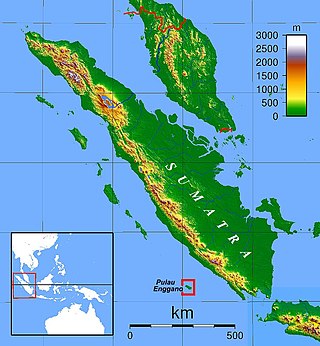
The Enggano language, or Engganese, is an Austronesian language spoken on Enggano Island off the southwestern coast of Sumatra, Indonesia.
The Proto-Philippine language is a reconstructed ancestral proto-language of the Philippine languages, a proposed subgroup of the Austronesian languages which includes all languages within the Philippines as well as those within the northern portions of Sulawesi in Indonesia. Proto-Philippine is not directly attested to in any written work, but linguistic reconstruction by the comparative method has found regular similarities among languages that cannot be explained by coincidence or word-borrowing.
References
- ↑ Dempwolff, Otto (1934–37). Vergleichende Lautlehre des austronesischen Wortschatzes. (Beihefte zur Zeitschrift für Eingeborenen-Sprachen 15;17;19). Berlin: Dietrich Reimer. (3 vols.)
- 1 2 Blust, Robert (2009). The Austronesian languages. Pacific Linguistics, Research School of Pacific and Asian Studies, The Australian National University. ISBN 978-0-85883-602-0.
- ↑ Dyen, Isidore. (1951). Proto-Malayo-Polynesian *Z. Language, 27(4), 534–540.
- ↑ Blench, Roger. 2016. The boiling pot: 4000 years ago in the Luzon straits.
- ↑ Blust, Robert; Trussel, Stephen (April 25, 2020). "Austronesian Comparative Dictionary, web edition" . Retrieved May 1, 2020.
- ↑ Kew Science. "Canarium commune L." Plants of the World Online. Royal Botanic Gardens, Kew. Retrieved 27 January 2022.
- ↑ Kew Science. "Canarium indicum L." Plants of the World Online. Royal Botanic Gardens, Kew. Retrieved 27 January 2022.